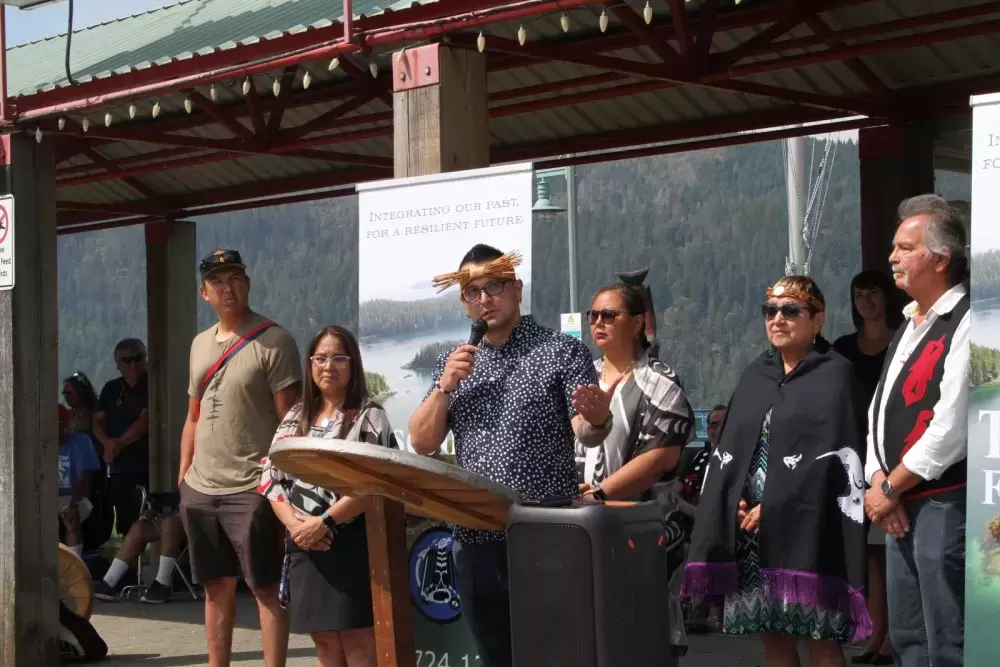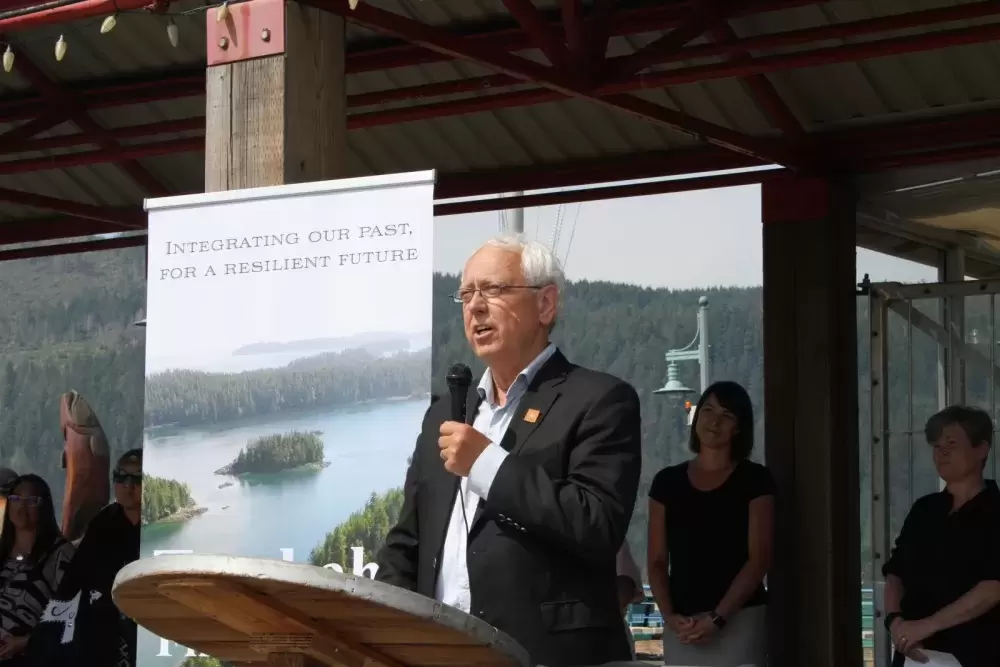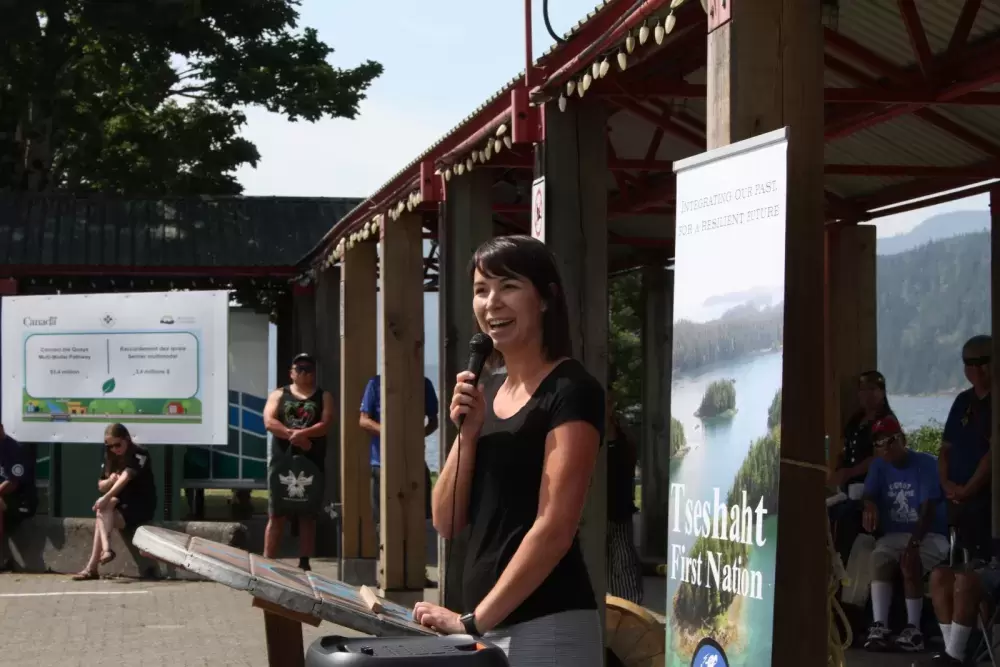In what is being called funding for the first stage of Tseshaht’s large-scale housing development, the province has given the First Nation $5 million for the purchase of land in Port Alberni.
The announcement was made at the base of the Wolf Tower at Port Alberni’s Harbour Quay on July 6, the site of the historic village of ƛuukᵂatquuʔis, where Tseshaht lived in the winter. With the $5 million in provincial funds, the Tseshaht and B.C.’s Ministry of Indigenous Relations and Reconciliation announced that the land purchases will lead to much-needed housing for the First Nation’s members, as well as others in the Alberni Valley, which is within the First Nation’s territory.
Two blocks away from where the announcement was held stood the Thunderbird Building, a multiple-storey residential, administrative and commercial complex opened by the Uchucklesaht Tribe in 2017. The Huu-ay-aht and Ahousaht First Nations have also began housing developments in Port Alberni for their members, now it’s time for Tseshaht to ensure their people have homes in their territory, said Chief Councillor Ken Watts.
“It’s our time to build housing here in our community,” he said. “I get excited when I think about the potential of 25, 50-unit buildings here in our community, here in our Ḥahuułi of Port Alberni for our people.”
For years Port Alberni marketed itself as one of the West Coast’s most affordable communities. But from 2015 to 2020 the average purchase price of a residence spiked from well under $200,000 to over $300,000, according to the city’s most recent Housing Needs Assessment. Meanwhile vacancy rates dropped under five per cent over the same period.
“We are in a housing crisis in the Alberni Valley, like so many other communities as well, but what we have here are willing partners willing to take on a challenge and really make a difference,” said Mayor Sharie Minions.
With 1,186 members, 461 Tseshaht live on reserve, according to the most recent data from the Nuu-chah-nulth Tribal Council, while many others reside within Port Alberni’s city limits. The First Nation is currently designing a subdivision expansion on its reserve for 35 potential units, but there are limitations to on-reserve development.
“The overcrowding has been happening for years. We haven’t built a home for a number of years,” said Watts. “We’re running into issues on reserve. We have 100 hectares of land that’s in our research and scanning area for the Alberni Indian Residential School. That’s basically put a moratorium on all of that property until we’ve scanned it.”
The First Nation has identified the need for 200 more homes for its community, but the Tseshaht hope to be part of Port Alberni’s future housing plans.
“[M]ore than 1,000 additional subsidized dwelling units are needed to provide affordable housing for residents,” stated the city’s Housing Needs Assessment.
A working group with representatives from Tseshaht, the city and the provincial government has been formed “to ensure a coordinated, collaborative and informed approach to tackling the housing crisis,” stated a joint press release from the First Nation and the Ministry of Indigenous Relations.
“Five million dollars is enough to purchase land, but it’s not going to be enough to build,” said Murray Rankin, minister of Indigenous Relations and Reconciliation, of the Tseshaht’s housing plans. “They had in mind a $50-million commitment, we don’t know whether that’s going to be sufficient, maybe it’s more than enough, but we’re going to work together.”
Watts said that the additional funding is in place, and that the Tseshaht are already in discussions with one private landowner. The First Nation plans to establish a non-profit housing society as well as a market rental company. On July 6 another $150,000 was committed by the province in capacity funding to help Tseshaht hire people to refine their housing development plans.
“The funding is already there, quite frankly, it’s about us organizing our society, our non-profit housing society and really getting our infrastructure set up,” said Watts. “If we can get 200 built utilizing this $5 million to purchase various properties, that would be awesome.”
Meanwhile provincial officials and the First Nation have met regularly to develop a reconciliation agreement. Rankin describes these talks as an alternative to a treaty, prioritizing long-term economic development, along with education, health care and child welfare initiatives.
“If Tseshaht wants a constructive arrangement outside of treaty, we’re willing partners in that,” said Rankin. “They’re very big on trying to find work and economic opportunities, investment opportunities, because they want to address some of the social issues that exist in their community and in Port Alberni.”
“We want to reconcile some of the things that have happened in the past for Tseshaht and find a path forward,” noted Watts. “This is a sign of good faith that we’re moving forward in a good way.”
Mid Island-Pacific Rim MLA Josie Osborne was also present at the announcement, noting the irony in Tseshaht needing to buy land in its own territory.
“I will point out the irony of purchasing lands, essentially giving back to the rightful owners of these places - the people who have cared for these lands and these waters and people for millennia,” she said.




